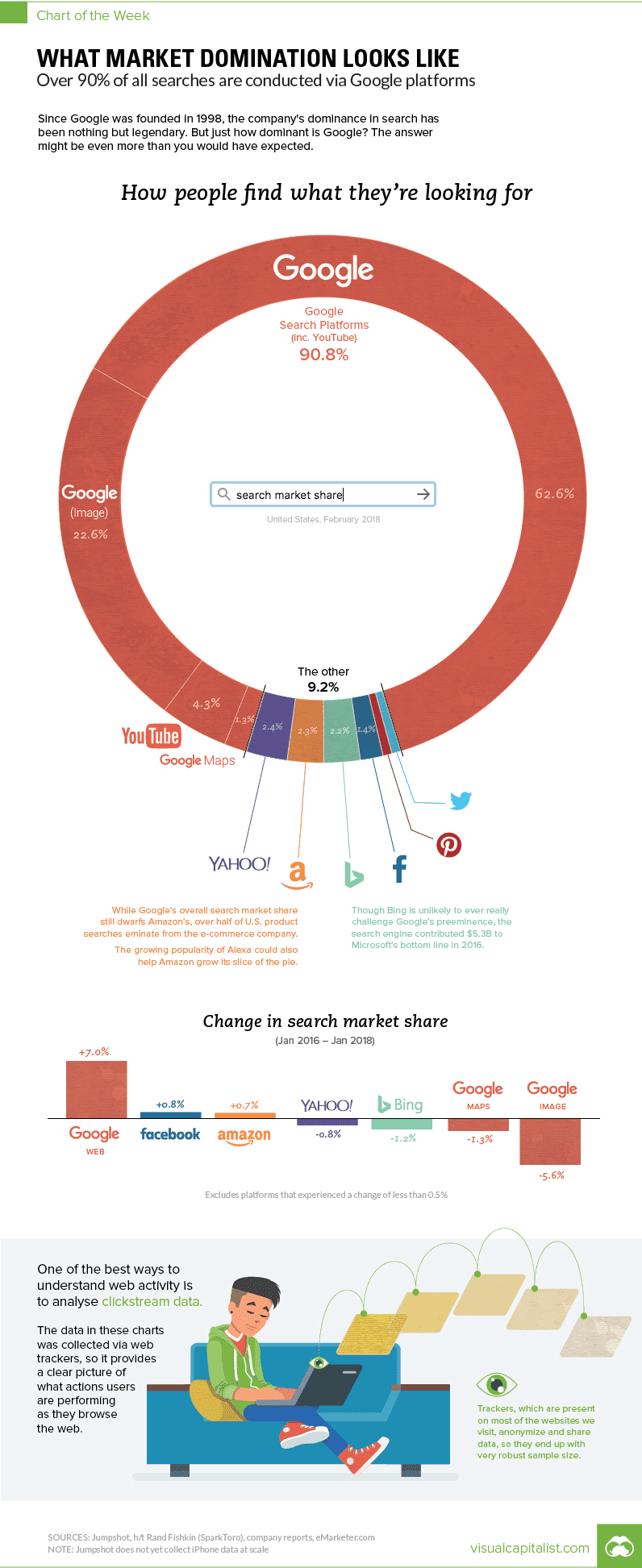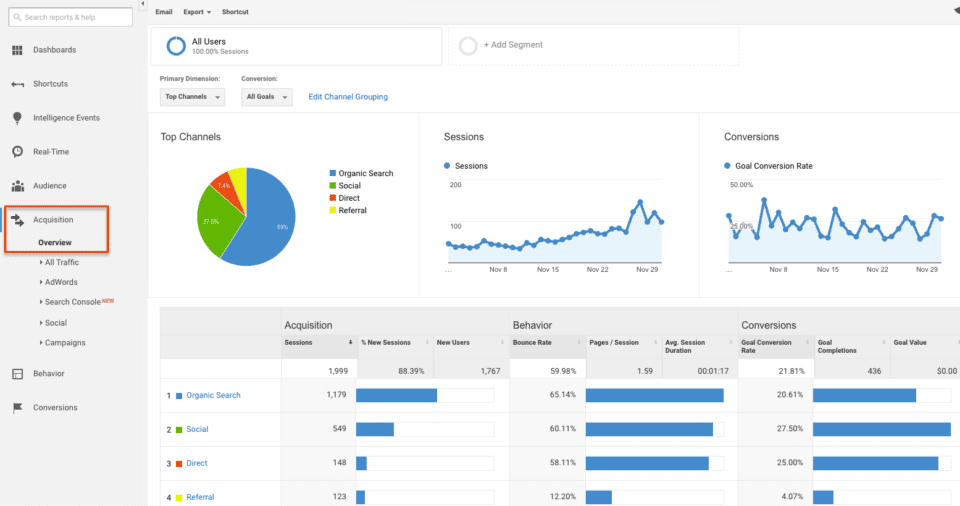Google holds an impressive share of searches – 90.8%! Obviously, what Google says, thinks, and does matters a lot.
Since its entry into the digital realm in 1998, Google’s dominance in search has been nothing short of legendary.
With millions of users performing billions of searches a day, Google is typically the first place they go.
And that’s because its reputation precedes it. Users trust the quality of the information it provides and believe in its mission.

What’s Google’s Mission?
Larry Page, Google CEO, claims that the company’s mission is to identify the problems people face and then develop technologies to solve them.
Though Google may have several goals, the three most common ones are:
Provide Appropriate Search Results
Google bestows a variety of services, such as Google Maps, Google My Business, etc. But because we primarily think of Google as a search engine, we rely on it for answers.
Essentially, its job is to help collect and organize a substantial amount of data from all over the world.
Moreover, with a single click, useful information is universally accessible – from facts, statistics, images, directions, services, and much more.
Improve the Quality of Data
Google is constantly upgrading the algorithms for its SERPs rankings. This practice is important to eliminate low-quality content and black hat SEO practices.
Currently, some qualities that Google is interested in — with respect to content — include:
- Uniqueness
- Relevance
- Value
- Mobile-friendliness
- Loading times
- Additional links
Google rewards sites that perform better and have high-quality content. It places them higher up on the results pages.
But this is only the beginning — SEO is a whole new ball game. So let’s leave the details for another day.
Enhance The User Experience
And it’s not only about content. It’s also about online engagement.
Google recognizes the way people interact with a website. There are tools such as Google Analytics that measure user engagement KPIs.
This provides a great deal if insight into a user’s online experience. Therefore, it’s vital to consider a user’s experience for both online as well as app usage.
How is This All Possible?
The key is information. Google gathers, processes, and stores information about a user’s behavior.
Algorithms sift through massive databases. Data is collected from many different sources, such as:
- Web pages
- User-submitted content, e.g. Google My Business and Maps user submissions
- Book scanning
- Public databases on the Internet
The way a user behaves on the page provides a considerable amount of information about the person’s level of engagement.
User engagement is an expansive subject, so let’s start from the beginning.
What is User Engagement?
User engagement evaluates an individual’s interest in a website, product, or service. It is measured by a variety of activities, for example, downloads, clicks, shares, etc.
However, this varies from company to company, depending upon their business model.
Why is Engagement Important?
People today have a short attention span. They are continuously in the search for something better.
With the sheer number of options available in the digital world, brands are forced to battle over the user’s attention.
Needless to say, engagement is highly correlated with profitability. So if a person spends time on a site, it’s a signal that they find it valuable.
As the individual engages with a brand, the business has the opportunity to make money through sales, ads, subscriptions, etc.
But more importantly, highly engaged people are more likely to become loyal customers.
They may share their experiences with others through links or referrals as well as return for repeat interactions.
Since Google values user engagement and experience, brands are aiming to improve their standards to get on Google’s good side. This can be achieved through:
- Creating appreciable content
- Encouraging interactions, such as filling forms, completing Calls-to-Action (CTAs), communicating with chatbots, etc.
- Prompting active participation like comments, discussions, etc.
- Incorporating social shares
- Maximizing the quality of all visual-oriented content
On a side note, for those of you who are interested in making killer content, here is more information about this topic: “10 Content Creation Tools Every Marketer Should Have”
What Metrics Should Brands Focus On?
User engagement is essential; therefore monitoring it is crucial for success.
There are various KPIs that facilitate the process. Before diving headfirst into this subject, you’ll want to first know which are suitable for your business.
Some common (and important) metrics include:
- Pageviews
- Time on page
- Bounce rates
- Pages per session
- Page/scroll depth
- Top exit pages
- Abandonment rate
- New and returning visitors
- Conversion rates

The individual correlations aren’t that significant. For instance, Moz.com stated that there was a slight relationship (0.12) between how long a visitor spent on a particular site and Google rankings.
Similarly, 0.10 correlation was noticed between the number of pages a visitor views and higher rankings. Meanwhile, a lower bounce rate indicated better user engagement.
On a broader scale, the collective effect of user engagement metrics can matter to rankings. Bottom line — you need to enhance your user engagement for a range of reasons, including SEO and rankings.
How To Boost User Engagement
The overall target should be to keep engagement as well as interactivity high throughout the site.
There are several ways to improve user engagement on your website, including:
- Declutter the site so that all of the essential aspects standout
- Streamline the website so that it’s easy to navigate
- Use appropriate contrast to make the website attractive yet easily legible
- Optimize loading speeds
- Produce valuable, lengthy content that is structured into blocks
- Aim at producing an ongoing series of content to promote long-term and repeat interaction
- Incorporate the use of visuals such as images, infographics, videos, etc.
- Employ chatbots to facilitate communication with users
- Ensure that the website is mobile-friendly
- Adopt future trends such as augmented reality, virtual reality, voice search, artificial intelligence, semantic keyword targeting, etc.
How To Promote User Engagement
To make the most of user engagement, you’ll want to target content at your audience with the intent of creating a response.
Start by gathering email addresses, asking questions, releasing surveys, etc. Think of anything you can do to get customers into your marketing funnel.
Analyze the data and tweak your website according to the results. That way, you’ll be able to gather worthwhile insight on how to appeal to a broader audience.
Final Thoughts
Boosting user engagement is hard work. But it begins with realistically assessing the current state of your website.
Focus on creating and marketing content that your target audience wants to read, optimizing your website, and boosting user experience. The rewards will come after you do.
Feature Image Credit: CC 0; Public Domain, sourced from Flickr.
Disclaimer: The views and opinions stated in this post are that of the author, and Return On Now may or may not agree with any or all of the commentary.
Alma Causey
Latest posts by Alma Causey (see all)
- Why Ecommerce Website Builders Are Great for Frugal Entrepreneurs - February 11, 2020
- Why Google Loves Websites that Exhibit Strong User Engagement - December 10, 2019





